If you are a fan of fireplaces but want a more efficient solution to your heating needs, then a wood-burning stove is the answer.
Instead of gas and petroleum, you can use wood as your fuel and get much more heat than you would from a traditional fireplace.
Before we get into the best wood-burning stoves, let’s see their major uses and characteristics.
At a Glance: Our Top Picks for Small Wood Burning Stoves
- OUR TOP PICK: Guide Gear Outdoor Wood Stove
- RUNNER-UP: TMS Portable STOVE-2346
- BEST BUDGET OPTION: Winnerwell Nomad Medium Tent Stove
Comparison of the Best Small Wood Burning Stoves
| IMAGE | PRODUCT | |
|---|---|---|
Our Top Pick  |
| View Latest Price → |
 |
| View Latest Price → |
Best Budget Option  |
| View Latest Price → |
 |
| View Latest Price → |
 |
| View Latest Price → |
What Should I Look for When Buying a Small Wood Burning Stove?
Although these stoves sound great in theory, their safety level is lower than an electric heater, so you cannot buy them without doing your research. You need to make sure you only get the best quality and the safest models. Here are some of the things you should look for in a stove:
Ease of Use
One of the things that make people prefer electric heaters is how easy they are to turn on and shut down. They also love that they require little to no maintenance. So if you are not used to wood stoves, you will want a one that is relatively simple to use. Modern wood-burning stoves are much easier to operate, but you should still look at the manual and see if they are your cup of tea.
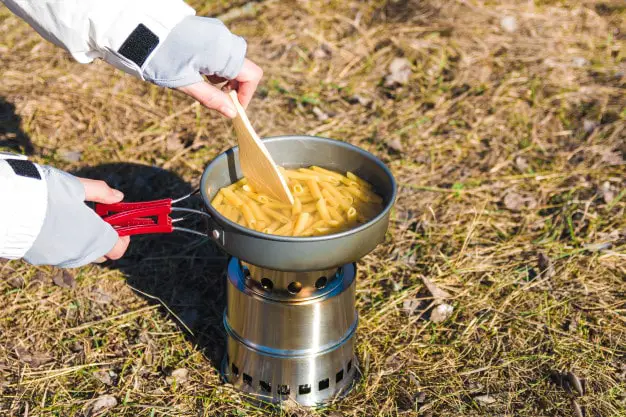
EPA (Environmental Protection Agency) Certification
Although using wood as fuel is more environment-friendly than fossil-based products, there is still a limit imposed on the amount of acceptable emissions. The latest standard is 2.5 g/h only. It used to be 4.5 g/h. Most of the stoves right now might still have the older standard.
You should also check the stove’s BTUs and see how much heating power your space will require. BTU is the amount of heat needed to increase one pound of water’s temperature by one degree Fahrenheit. An average 2,600-square-feet home needs 20,000 BTU per hour to stay warm.
Safety
Safety is of utmost importance with anything that makes use of fire. The gate around the burning area of the stove should be securely locked so that a child will not be able to open it. Before using it, check for any cracks in the surface.
The only acceptable construction materials for such stoves are cast iron, steel, and stone. Also, check if it has a UL-certification to ensure the product is safe to use.
Review of the Best Small Wood Burning Stoves
Now that we have the basics of a wood-burning stove out of the way, you will see that there are different versions present on the market. Some vary in their design; some vary in the materials used, while others vary in size. Keeping in mind your budget, you have to make a choice that best suits your heating needs. Here are our top options:
Best Overall
Guide Gear Outdoor Wood Stove
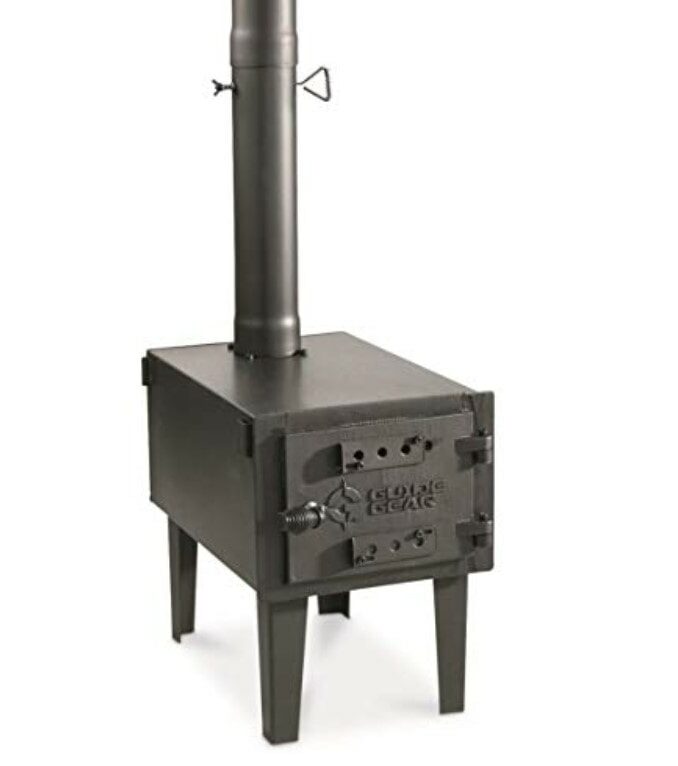
We may earn commission from purchases made from our links, at no additional cost to you
What Recent Buyers Report
Planning a camping trip in winter has become much easier and more fun with this portable wood burner. You can easily set it up outdoors and have a heater-stove combo because you need a place to cook your meal when you are not home. The space on top is large enough for a kettle or a cooking pan.
Why it Stands Out to Us
The stove is made of galvanized steel with a heat-resistant finish. The galvanization process protects the box from rust and corrosion while the heat-resistant finish protects the box from getting damaged by constant contact with high heat.
The front door through which you put the wood in is made of cast iron. Cast iron is known for its resistance to indentation, ability to absorb energy, and its strength. This door has an adjustable air vent that gives you control over the heat. You can improve air intake by opening the vent all the way.
It also has a spark arrestor at the top of the chimney for safety. The stove is easily portable and has a cool-to-touch handle to make carrying it easy. The damper in the chimney is also adjustable to help you control the ventilation.
Bottom Line
A cast iron and galvanized steel stove make for one of the sturdiest and most durable products. This model is easy to use and gives you plenty of control over the amount of air available to the wood for burning. This way, you can control the temperature of the area better.
Pros
Easy to transport
Vents are adjustable
Handle is cool to touch
Has a heat-resistant finish
Room for heating a small pan
Cons
Only suitable for outdoor use
Runner-up
TMS Portable STOVE-2346

We may earn commission from purchases made from our links, at no additional cost to you
What Recent Buyers Report
This is a heavy stove/heater. It is easy to clean and doesn’t cost too much. The paint on it burns off very easily, but it produces good heat and is pretty durable. Most users just replaced the paint with heat-resistant paint themselves and stated that it did not affect the heating capability.
Why it Stands Out to Us
The military-style (TMP) camp stove says it all in the name. It is a heavy-duty burner that keeps you warm outdoors and doubles as a small grill. The two tubs on either side can cook potatoes and foil meals. The top grate, when opened, can be used to dry out socks and gloves as well.
The spark arrester at the top keeps flammable debris from causing a fire hazard. This is especially important if you are in a forest. There are airflow regulators at the front and back that give control over the air allowed in. Its maintenance and cleaning are made easy with a removable ash-tray.
When you fold the grate, it acts as a carrying handle to move and store it. The legs are removable to make it more portable. It also has some tools and a stovepipe cap included with it.
Bottom Line
Overall, this stove is bigger and a bit heavier than our first pick, but it functions just as well. It is designed to work as an all-in-one product. It takes care of all your heating needs outside the home, i.e., keeping warm, cooking, drying, etc.
Pros
Two removable cooking tubes
Has a spark arrester for safety
Removable legs for easy storage
Stove tools are included in the package
Two airflow regulators to maintain heat
Cons
Paint easily burns off
Best for the Money
Winnerwell Nomad Medium Tent Stove

We may earn commission from purchases made from our links, at no additional cost to you
What Recent Buyers Report
According to users, this stove’s stainless steel construction makes it a great choice if you are not a fan of the old-looking and rusty heaters. It has great clean finishing and is quick to warm up any room or tent. The construction is top-quality, and the accessories meet the standards as well.
Why it Stands Out to Us
304 stainless steel is one of the most common types of stainless steel. It has high nickel and chromium content, which makes it an excellent resistor to corrosion. Due to its properties, it is widely used in heat exchangers and pipes. This stove also makes use of its properties in its construction.
It is designed to be very portable; it has foldable legs and pipes that stow inside the stove body. The side selves are folded together and used as handles for carrying. It also comes with a spark arrestor and an ash scraper for cleaning. The dual dampers make airflow control easy, and the side shelves that act as handles are also used as cooking areas.
Instead of a completely locked door, there is a glass to let you view the fire and make changes when necessary. It is recommended to be used in buses, trailers, tents, etc.
Bottom Line
With a not too heavy and compact design, this stove is easy to carry around when camping and does not overburden the mobile home or bus when it is moving. It is a great option for anyone who is looking for a recreational wood burning stove.
Pros
Rust and corrosion-resistant
Side shelves double as handles
Can easily fit into vans or trailers
Two dampers to control the heat
Lightweight and easy to transport
Cons
Suitable only for tight areas
Ohuhu Camping Stove

We may earn commission from purchases made from our links, at no additional cost to you
What Recent Buyers Report
Users loved that no installation cost or time was wasted on this stove. You don’t need to buy pipes and drill holes, which is why it is a favorite with novice users. Users who need a cooker more than a heater love this product as it is made for just that.
Why it Stands Out to Us
This is a very compact stove that can be used for both barbeque and normal cooking. When you remove the top part and put it in the grill, it can be used for barbecuing. Unlike other such stoves, it is more stable. There is a three-arm base support system on top of which your foot goes. This keeps it from falling over.
It is made of high-quality stainless steel for corrosion resistance and durability. It is very compact and has its own carrying bag that it comes with for portability and storage.
You can use all kinds of things for fuel like wood, leaves, twigs, and pinecones; basically, everything you find in nature around you. This saves you a lot of fuel costs as well. It is also very environment-friendly as it does not need fuel canisters or alcohol.
Bottom Line
Looking to spend some days in nature and leaving your troubles behind? You cannot leave without a proper food supply and cooking arrangements. This stainless steel stove gives stable and high heat throughout and keeps you warm in the process.
Pros
Very easy to use
Compact and easy to carry
A very stable and safe base
Flexible when it comes to the fuel
Works as a kitchen when camping
Cons
Only suitable for cooking and not for heating
Drolet HT3000
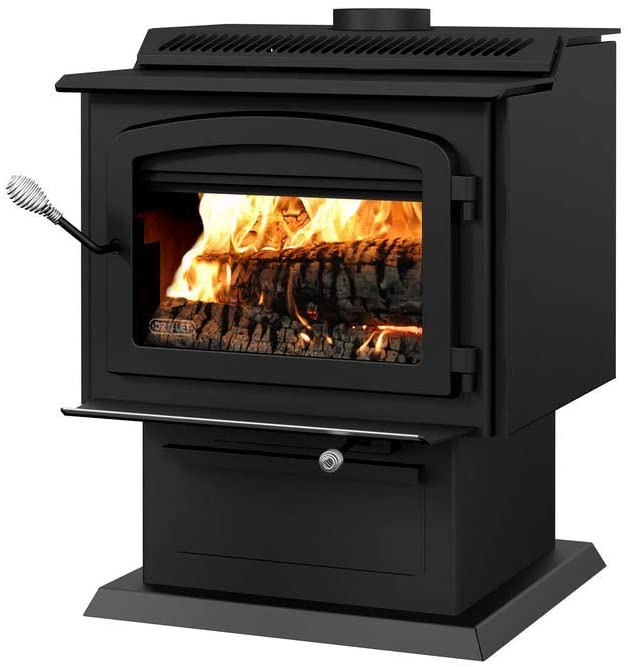
We may earn commission from purchases made from our links, at no additional cost to you
What Recent Buyers Report
This stove has one of the best ambiance, similar to what you get from a fireplace. Its heat is very good, and it is not difficult to use at all. The only hard part is installing it, and after that, the maintenance is not too difficult. Even with the damper turned down, you can keep your space comfortably warm.
Why it Stands Out to Us
The HT3000 is a newer model and an improvement of Drolet’s older stoves. It accommodates the new emission standards set by the EPA. Its emissions are lowered to only 1.32 g/h. Its maximum heat output is 110,000 BTU per hour. You can heat a big area with it easily, and you can turn down the heat using the adjustable dampers.
It has a glass front door with a cast iron frame that gives both security and great ambiance. To improve combustion, it has a secondary air system. It gives the wood more air to burn better. For even heat distribution, the firebox is lined with refractory bricks or fire bricks that are made to handle high heat and used in things like a kiln or a furnace.
Bottom Line
Out of all our top picks, this is the most expensive option, but it justifies it with its high-quality construction, ambiance, and extra-low emissions. This new product is a must-have if you are looking to improve your home heating this winter.
Pros
Gives 110,000 BTU/h heat
Can be installed in a mobile home
Cast iron construction for durability
Follows the latest EPA standards of fuel emission
A secondary air system for better gas combustion
Cons
Not portable
When Would a Small Wood Burning Stove Come in Handy?
A wood-burning stove can come in handy on a number of occasions. These include:
Heating
You want to use a small wood burning stove if the area you want to heat is not too big. A small living room or bedroom can be made very cozy in the severe winter season as well.
It can also serve as your secondary cooking area. You can boil water or make tea and complete the winter essentials list. Some even let you cook your eggs and potatoes, etc.
An added advantage is that the stove will keep heating even when the electricity is out. So if there is a bad storm or a long power outage, you will remain comfortable. You can use it during camping as well. It can keep your tent warm, but it should have good ventilation.
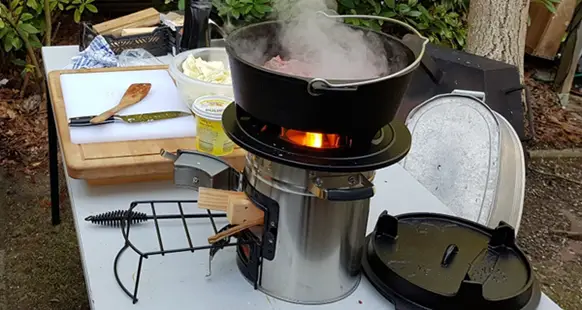
Cooking
Of course, you can use a stove for cooking. The flat surface on top is used to place pots or pans. Doing two things with one appliance saves money for the product and fuel. The stove can even be used to raise bread. Bread needs a warm environment to raise, and the heat from the stove gives it that.
Dehydrating
You can use a wood pellet stove to dehydrate food like vegetables and fruits. Similarly, if the power has gone off or the dryer isn’t working, you can hang wet clothes above or behind it and use its heat to dry them.
Pellet Stove vs. Wood Burning Stove for Small Spaces – Comparison Overview
Pellet and wood-burning stoves belong in the same category, but certain features define each and make them stand out from the other. Let’s have a look!

Similarities
There are a few things that will make you think that both pellet and wood-burning stoves are the same and make you confused as to which one you should buy. These include:
Look
One thing that is similar in both is the design of the stove. They are both known for their square firebox that looks like and gives the feel of a fireplace. The similarity is completed when you add a glass door. Their construction materials are also very similar, i.e., cast iron, stone, etc.
Produce Fire
Unlike the new electric heaters, these two stoves use actual fire to heat up your home despite the difference in fuel.
Differences
Let’s now go through the differences. These are what help you determine which product will suit your needs better.
Fuel
This is the major difference between the two stoves. A wood-burning stove needs logs to work, and as a result, it produces a lot of ash and flue gases. A pellet stove, on the other hand, uses pellets. There are different kinds of pellets, including biomass, industrial waste, agricultural waste, and wood chips.
Chimney
Pellet stoves are easier and less costly to install as they do not need a chimney, as wood stoves do. The ventilation of a pellet stove is done through a sidewall.
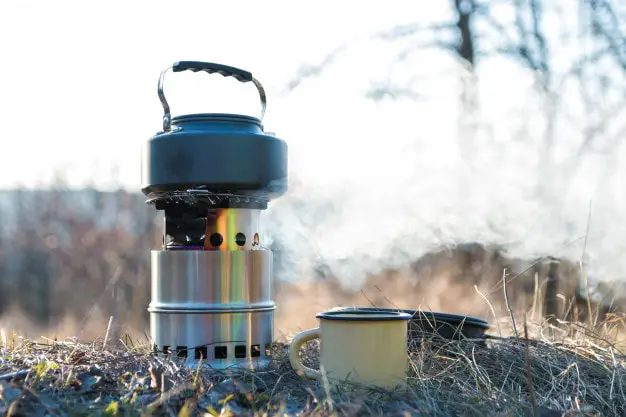
How to Install a Small Wood Burning Stove
Installing wood-burning stoves can be daunting as you need to make sure of a lot of things along the way. They include but are not limited to making sure there is enough ventilation, making room for the pipes to go out, keeping the floor below the stove safe, etc.
If you do it properly, there should be no problems. You can follow these steps to get you started.
- First, check for a well-ventilated area in your home like near a window.
- Instead of putting the stove directly on top of the floor, first, install a hearth below it to protect it against the heat. You can make it yourself or have it installed.
- Next, put your stove on top of it.
- Take a string with some weight attached to one end. Hang the string from the roof to the top of the chimney hole on the stove and mark the location on the roof. This will make sure that the chimney is installed straight.
- Use a stud finder to locate the studs in your wall. You want the chimney to go between the studs, so mark those areas, so you don’t accidentally drill there.
- Once done, drill a small hole in the center of the studs where you will install the pipes.
- Mark the area for the firebox that needs to be installed with the pipes around the center hole. The mark should be the exact size of the box.
- Drill four holes on all corners of the box you drew on the ceiling and use a drywall saw to cut out the shape. You can also use a more powerful tool if that doesn’t work for your ceiling.
- Install the firebox in the square hole you just cut with the pipe extending outwards.
- Make sure that the box is straight and then drill in the box to secure it (do it from the outer side).
- Use a flashing sealer to waterproof the flashing, which will go on top of the pipe, extending from the firebox.
- Then screw the flashing in using the screwdriver.
- Attach the topmost pipe on top of the other pipe by putting it on and turning it.
- You will hear a click to let you know that it is secure.
- On the other side of the firebox, screw on the pipe connector around the hole in the firebox where the pipes are supposed to go.
- Install the final pipe between the stove and the firebox. Screw it in securely and make sure that it is straight.
- If your stove comes with an electric fan, you just need to screw it in at the back and connect it to an outlet.
- For the final exhaust pipe that goes from the bottom of the stove directly outside, draw a circle with the exact size of the pipe.
- Drill a hole at the center of the circle and mark that as your center point. Cut out the circle from the outside.
- Install the pipe in the hole and secure it in place using a drill.
These are the basic instructions to follow, but every stove should come with instructions of its own. If you are lost at any point, you should refer to that as some stoves can have different requirements.
For more tips and visual instructions on installing a wood-burning stove, refer to the video below.
Conclusion
That was all for small wood-burning stoves. They are great for mobile homes, camping, and cabins. Their multitasking ability and the vintage fireplace feel makes them a favorite of many. But it is not all about the looks; they also save you plenty of money in fuel and are very efficient.
People Also Ask
If you are not convinced that you need a wood-burning stove or if you have more questions regarding it, you can read some frequently asked questions below.
Installing a wood-burning stove can cost around $250 to $800 for labor. The price can increase if you buy separate chimneys and ventilation systems.
A wood-burning stove costs around $400 to $2500, depending on the size.
The stove should be at least 18 inches from the wall and 36 inches from other combustible materials like wooden furniture, etc.
There are usually two venting areas on the stove, one at the button and one at the top. This is because wood needs a good supply of air to burn properly.
If your tent has a chimney opening and is made of canvas or polycotton, then you can use a wood-burning stove in it. This is because cotton is more breathable than man-made plastic materials.
Yes, you can use a wood burner in your shed.
This depends on the BTU output of your stove. But generally, they can easily heat up 1,500 square feet of space.

